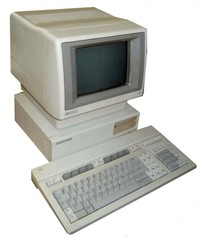HP 150B
| Home > Browse Our Collection > Computers > Hewlett Packard > HP 150B |
|
The HP-150, a "compact, powerful and innovative" computer made by Hewlett-Packard in 1983 and based on the Intel 8088, was one of the world's earliest commercialized touch screen computers. The machine was not IBM PC compatible, although it was MS-DOS compatible. Customized MS-DOS versions 2.01, 2.11 and 3.20 were available. Its 8088 CPU, rated at 8 MHz, was faster than the 4.77 MHz ones used by the IBM PC of that period. Using add-on cards, main memory could be increased from 256 KB (256 KiB) to 640 KB. However, its mainboard did not have a slot for the optional Intel 8087 math coprocessor due to space constraints. The HP-150 with an optional hard disk was called the "Touchscreen MAX". The screen is not a touch screen in the strict sense, but a 9" Sony CRT surrounded by infrared emitters and detectors which detect the position of any non-transparent object on the screen. In the original HP-150, these emitters & detectors were placed within small holes located in the inside of the monitor's bezel (which resulted in the bottom series of holes sometimes filling with dust and causing the touch screen to fail; until the dust was vacuumed from the holes). Like the Macintosh, the CPU was packaged with the CRT. Unlike the Mac, the 3½ disks were external. The 150 (code named "Magic") was introduced with great hoopla in October, 1983. It was HP's first MS-DOS PC, equipped with an Intel 8088 CPU. The market was already crowded with MS-DOS PCs, and vendors tried to differentiate their products with unique hardware features. In an attempt to make its offering easier to use, HP built in a touch screen feature to the 150. This allowed users to use screen-touching to replace many commands that would otherwise require the keyboard. The touchscreen feature consisted of a series of vertical and horizontal infrared light beams that crossed just in front of the screen. One of these vertical and horizontal beams was broken when a finger touched the screen, positioning the cursor at the desired location (or activating a soft function key). Encouraged by a study HP commissioned from McKinsey and Company, HP hoped to gain up to 22 percent of the PC market in the US within a year using the 150. But, the machine was priced over $1000 more than the IBM PC and ran non-standard software. HP managed to sell 40,000 units that first year, half of which were used as terminals on HP system computers. Introduction of the 150 more than tripled HP's PC revenues. HP sold just over $50M worth of 120/125 computers in 1983. Revenues jumped to over $160M in 1984, before falling back to under $140M in 1985. Introduced: November, 1983 MSRP: $2795 The 45611B Monitor system is an updated version of the HP 150. This is normally known as the HP150B. Had new ROMs to support new disk drives. Also had an improved RFI shield to lessen radio interference. Many HP 150As had the ROM upgrade and a few had the new RFI shield installed as well. Around this time, HP started marketing the HP 150 as the HP Touchscreen in the USA. Our machine, the 45611B which is complete with software and manuls including: Using Your Touchscreen II were all very kindly donated by Paul Churchley & Sally Buswell from Cornwall Manufacturer: Hewlett-Packard Comment on This Page Other Systems Related To HP 150B:
This exhibit has a reference ID of CH20973. Please quote this reference ID in any communication with the Centre for Computing History. |
|












